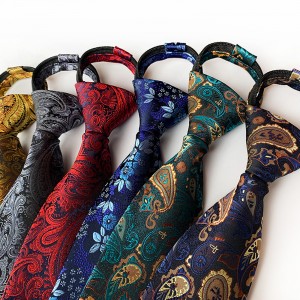Balzac, the father of the French novel, once said, “A tie is a man’s letter of introduction.” Necktie is a very good ornaments for men, like women who wear evening gowns, men who wear neckties will involuntarily hold their heads high, showing the man’s responsibility and charm.custom tie manufacturers
The necktie originated in warfare, when 17th century mercenaries wore a piece of cloth around their necks to tie up the neckline of their armor. At that time, King Louis XIII fell in love with this piece of cloth at first sight. Under the pretext of awarding soldiers, he ordered it to become a dress code for soldiers, which gradually became a tradition. This cloth later evolved into a bow tie and is considered the origin of the modern “necktie”.custom tie manufacturers
In the early 19th century, men wore all-black or all-white linen or thin cotton ties, and wore different ties to show their personality. Silk, which was expensive and difficult to weave, was not only impractical but also difficult to obtain; After the advent of the loom in 1801, it was possible to weave silk ties with local small patterns and to produce them in large quantities quickly.
The biggest leap forward in tie construction came in 1924, when New York tie maker Jesse Langsdorf turned silk at a 45-degree Angle before beginning to cut it, allowing it to stretch and increase its strength. By the ’50s and’ 60s, ties had shrunk to less than two inches in width, and the ’80s brought back the trend of narrow ties.
Tie structure custom tie manufacturers
The division of tie style is mainly printed and width, and width is often compared with color to convey the first intuitive feeling, mainly divided into wide ties and narrow ties.
The width of modern ties is roughly 8cm as the cut-off point. Those below 8cm belong to narrow ties, and those greater than 8cm belong to wide ties. Wide ties are mainly suitable for formal occasions. Narrow tie is a popular and young style in recent years, with a width of about 5-7cm. It can also be used on formal occasions, but it will appear young and fashionable.
Main manufacturing process
45 degrees of inclined cut
45 degrees oblique cutting is a special method of cutting along the diagonal direction of the fabric.
This way can maximize the flexibility and flexibility of the fabric, so as to adapt to the deformation caused by the mutual force of different parts of the tie when tying, so that the tie keeps vertical and smooth, without twisting and wrinkling.
To determine if a tie is hand-cut on a bias, do a stretch test, which has two measures: 1) Pull it up and down, and it should stretch; 2) Pull along the 45 degree direction, the tie should not stretch at all.
Jump needle
Hand sewn tie, open the back of the folded part of the tie, there is a coil, which plays a very important role in maintaining the shape of the tie, no matter what the tie is pulled into, as long as the flick of the needle loop, it can restore the original state.
The difficulty of this skipping technique is also reflected in that it has to run through the back folded sides of the tie and the lining, but it can not also sew on the front side, which is a test of technicians’ hands, and the machine can not do it.
Reinforcing bar tacking
On the back of the tie, there is a horizontal bowknot that sews the folded sides together like a stapler. Its main function is to strengthen the skip needle and ensure the stability of the tie.
If the tie has been worn for a period of time, it begins to appear not to stick to the phenomenon, a sense of bubble ups and downs, it is likely because there is no such knot.
The lining
A normal tie has a lining running through both ends, but some are unlined or half-lined. Full – lined draping is better than non – lined, appears stable.
printing
The level of printing directly determines the temperament of a tie. Poor quality prints often look dirty and gaudy. And the high level printing, the edge is clear, the color expression is vivid and full of spirit.
In traditional silk screen printing, the more colorful the tie, the more difficult and expensive it is to make, and the more “worth buying.”
Post time: Oct-31-2022


